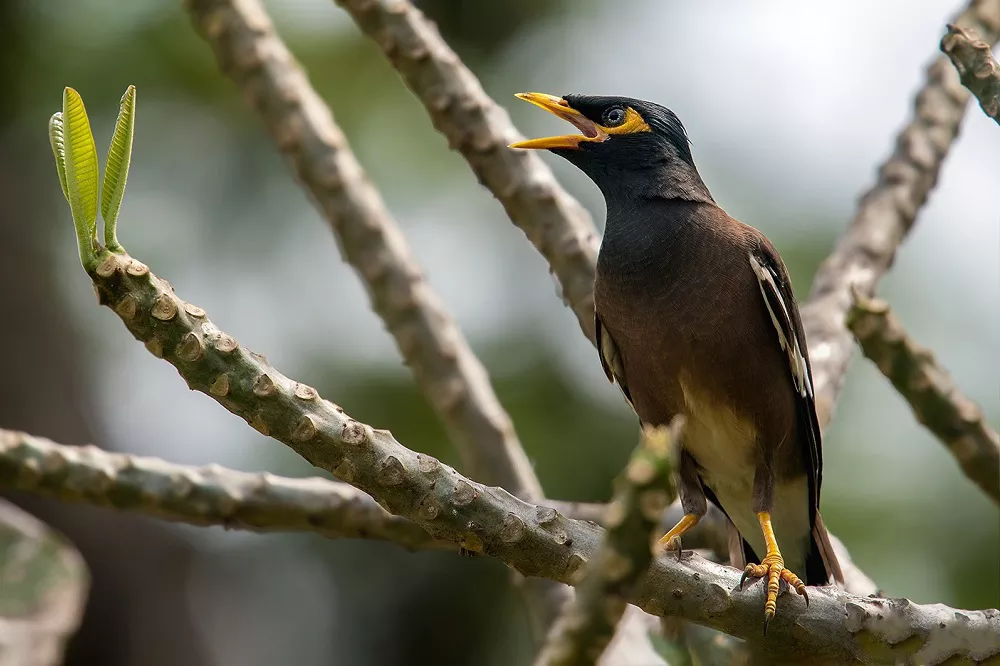The Indian Myna bird (Acridotheres tristis), originally introduced as a means of biological pest control, has emerged as a significant ecological threat across various regions of the world. This article delves into the reasons behind its classification as a pest, highlighting its impact on local ecosystems, native bird species, and human activities. Through a comprehensive review of scientific literature and ecological studies, this article sheds light on the multifaceted reasons that underscore the Indian Myna bird’s status as a pest.
The Indian Myna, native to South Asia, was introduced to various countries with the intent of controlling agricultural pests. However, it has rapidly transitioned from a biological pest control agent to a pest itself due to its aggressive behavior, prolific breeding, and detrimental impact on both natural environments and human habitats.
Ecological Impact:
One of the primary reasons for the Indian Myna’s pest status is its displacement of native bird species. By outcompeting indigenous birds for nesting sites and food resources, the Myna disrupts the delicate balance of ecosystems. Studies have shown that its presence can lead to declines in native bird populations, affecting biodiversity and ecosystem stability.
Aggressive Behavior and Human Interaction:
Indian Mynas exhibit territorial aggression towards other bird species, often displacing them from urban environments and parks. Their propensity to nest in man-made structures, including residential areas and buildings, raises concerns for human health and safety. Accumulation of bird droppings near human habitats can create unhygienic conditions and trigger allergic reactions in sensitive individuals.
Dietary Habits and Agricultural Impact:
Indian Mynas have an opportunistic diet, consuming a wide range of food items including fruits, insects, and human leftovers. Their foraging behavior can have negative implications for agricultural practices, as they may feed on crops and damage horticultural produce. This leads to economic losses for farmers and further solidifies their reputation as a pest.
Rapid Reproduction and Population Growth:
The Mynas’ ability to breed throughout the year and their relatively high reproductive rates contribute to their rapid population growth. A single pair can produce multiple clutches of eggs annually, resulting in population explosions that put additional pressure on already vulnerable ecosystems.
Spread of Disease:
The Indian Myna is also implicated in the spread of diseases, acting as vectors for pathogens that can affect both animals and humans. This has the potential to create public health concerns and further underscores the need for managing their population.
Management Strategies:
Several strategies have been proposed to mitigate the impact of Indian Mynas. These include habitat modification to limit nesting opportunities, use of deterrents such as noise devices, and implementing community-based programs to reduce food availability and enhance awareness about the issue.
Conclusion:
The Indian Myna bird’s transformation from a potential solution to a problem highlights the complexities of introducing non-native species for pest control. Its aggressive behavior, rapid reproduction, displacement of native species, and adverse effects on ecosystems have firmly established it as a pest. Effective management strategies, involving collaboration between scientific research, public education, and policy implementation, are essential to address the ecological and human-centric challenges posed by this invasive species.
FAQs About The Indian Myna Bird:
1. Can Indian Mynas be kept as pets?
In some regions, Indian Mynas are kept as pets due to their mimicking abilities and playful nature. However, in areas where they are invasive, it’s generally discouraged to keep them as pets to prevent their further spread.
2. How do Indian Mynas affect native bird populations?
Indian Mynas can negatively impact native bird populations by competing for resources like nesting sites, food, and breeding areas. Their aggression and adaptability often give them an advantage over native birds, leading to a decline in native species.
3. Are Indian Mynas invasive?
Yes, Indian Mynas are considered invasive in many parts of the world, including Australia and some Pacific islands. Their adaptability to urban environments and aggressive behavior towards native bird species have led to concerns about their impact on local ecosystems.
4. What do Indian Mynas eat?
Indian Mynas are omnivorous and have a varied diet. They feed on insects, fruits, vegetables, human food scraps, and even small vertebrates like lizards and baby birds. Their diet makes them successful scavengers in urban areas.
5. How did Indian Mynas spread to other countries?
Indian Mynas were intentionally introduced to several countries, including Australia, Fiji, and New Zealand, to control insect pests in agricultural areas. However, due to their rapid breeding, adaptable nature, and aggressive behavior, they have become a problem by outcompeting native bird species for resources.
6. Are Indian Mynas good mimics?
Yes, Indian Mynas are known for their exceptional mimicry abilities. They can imitate a wide range of sounds, including human speech, other bird calls, and even mechanical noises. This mimicry is one of the reasons they are popular as pets in some regions.


 Facebook
Facebook  Instagram
Instagram  Youtube
Youtube 